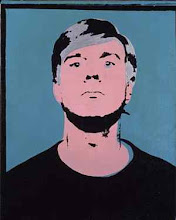 |
| Andy Warhol and William Morris |
I love Andy Warhol (see below); I love William Morris; I am also a bit of a fan of Jeremy Deller (see below). So I was pretty excited by the prospect of this exhibition. (With another of my heroes, William Blake, the subject of an exhibition at the Ashmolean (see below) a visit to Oxford was irresistable.)
Broadly, the premise for this suprising pairing of artists is that they both employed printmaking processes in collaborative factory production systems as a means to extend and distribute their art; they both employed repetition as a design principle; they both used flower imagery and made pictures of cultural heroes and myths; the show even tries to argue that Warhol's politics had some affinity with Morris' socialism.
However, I don't think it works: there are a few terrific pieces in the exhibition, but the juxtapositions are, too often, painful clashes rather than complementary contrasts. Two of Warhol's Electric Chair screenprints on a background of Morris' densely patterned wall paper does neither artist a favour. Generally, I think that Warhol is the loser in this contest: Morris' dense, highly crafted designs make Warhol's casual elegance look lightweight and thin. But it's an unfair contest - the earnest sincerity and idealism of Morris' nostalgic vision sits awkwardly with Warhol's ironic detachment. The fact that they both made wallpaper isn't enought to make them brothers in art. (In fact Morris and William Blake would make a much more sympathetic pairing; the Blake show, incidentally, is excellent.)
Read reviews by Waldemar Januszczak, Richard Dorment (he hated it!) and Farah Nayeri. Click on images to enlarge.
 |
| William Morris, printed fabric design: Kennet, 1883 |
 |
| William Morris, wall paper design: Acanthus, 1879 |
 |
| William Morris, wall paper: Acanthus, 1879 |
 |
| William Morris, 'Kelmscott Chaucer', 1896 |
 |
| William Morris, bound pamphlet: How I Became a Socialist, 1896 |
 |
| Andy Warhol, Elizabeth Taylor, 1967 |
 |
| Andy Warhol, Electric Chair, 1971 |
 |
| Andy Warhol, Flowers, 1970 |
 |
| Andy Warhol, Cow wallpaper, 1971 |
 |
| Love is Enough... installation featuring Andy Warhol, Marilyn Tapestry, 1968 and photograph of Shirley Temple (1941) from Warhol's collection, on wallpaper by William Morris |
 |
| Love is Enough... installation |














